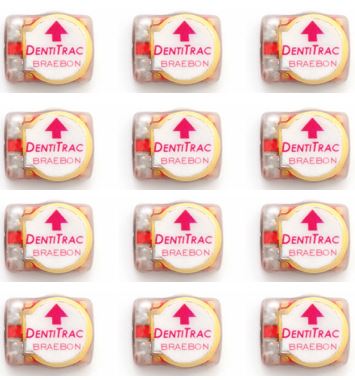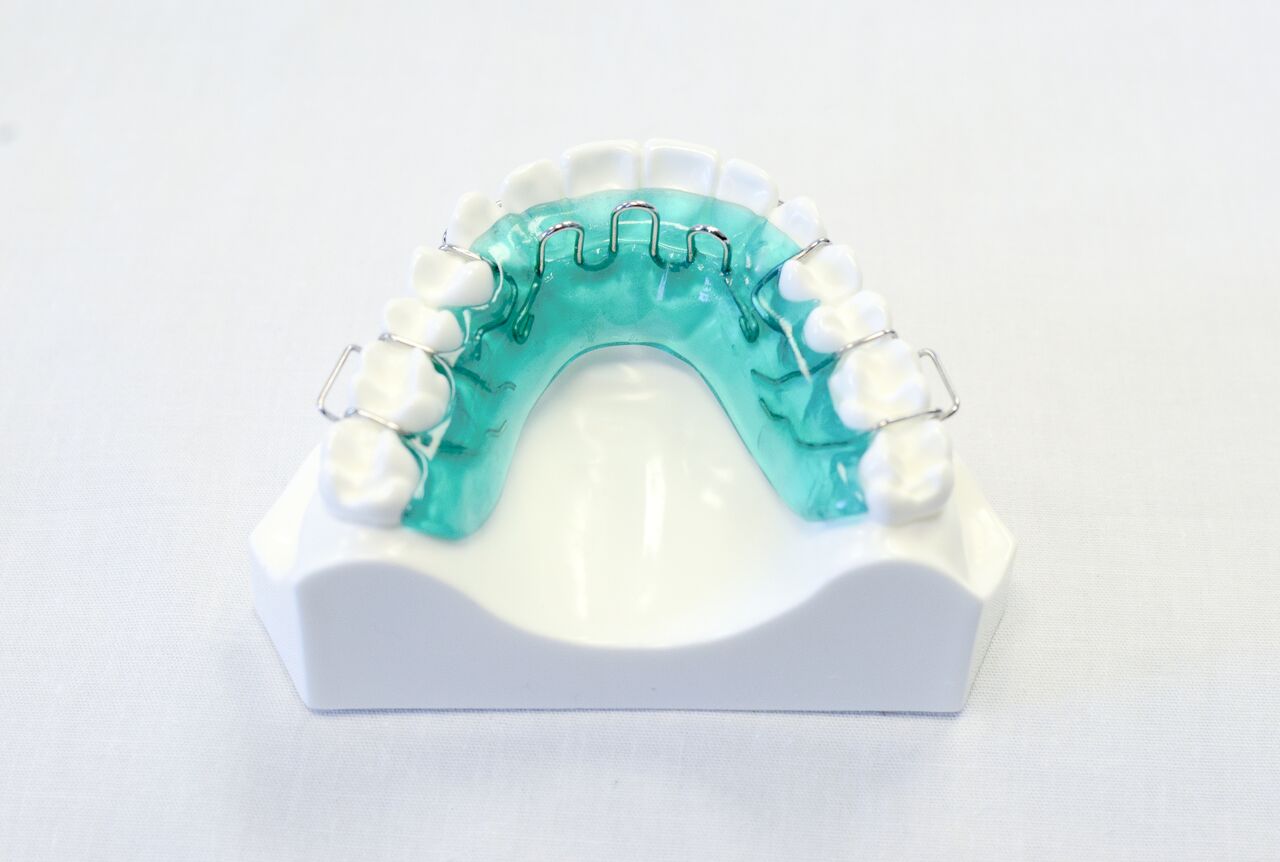The Regular Hawley is the most widely-used type of retainer in the Orthodontic field. On either a plaster or stone model, a thin layer of acrylic is applied evenly and precisely. This layer contours the lingual surface of teeth. A labial wire is in contact with the buccal surface of incisors and cuspids. Then, adjustments can be made with the wire loops that are placed on either side of the maxillary arch. The loops can be adjusted quite easily with Orthodontic pliers.
The Regular Hawley is the most widely-used type of retainer. On either a plaster or stone model, a thin layer of acrylic is applied evenly and precisely. This layer contours the lingual surface of teeth. A labial wire is in contact with the buccal surface of incisors and cuspids. Then, adjustments may be made with the compensation loops that are placed on either side of the maxillary.
The wires of Adam clasps cause discomfort to patients whose occlusion is quite tight. Indeed, patients chew not with their teeth but on their retainer wires. In order to address this problem, the Adam clasp is replaced with a circular clasp. Because of this type of clasp, the Hawley appliance takes on its Wrap Around designation. The circular clasp extends along the distal surface of the last molars, where there is usually little occlusal contact. It should be said that a C-clasp also provides similar results.
Unlike the rounded wire, the multi-strand soft wire is flexible because of its 0.019″ size. It contours the lingual surface of cuspids and incisors perfectly. In order to prevent crowding, this wire must be bonded on each tooth. Moreover, this multi-strand soft wire can replace the regular Hawley on the mandible because it is comfortable to wear and aesthetic. Transfer methods- Two methods may be used to transfer these retention lingual wires to patients. Incisors can be coated with a silicone mixture. With this method, clinical practitioners must first bond the cuspids, then gently remove the silicone envelope and finally bond the incisors. In order to facilitate the transfer of multi-strand soft wires, we add acrylic to the buccal surface of cuspids and incisors. Acrylic maintains the wire into the proper position. Practitioners can therefore bond the wire easily.
Built on the upper or lower jaw, the 3a3 Bond-a-Braid is our top of the line retaining wire for long-term retention. This flat wire is stranded and flattened, making it as flexible as a regular stranded wire. However, it is twice thinner in width, which makes it that much more comfortable. This wire is delivered passive, 100 % adjusted to its transfer matrix. The anchoring composite is added on the patient’s teeth. The wire is then cut at the canines’ distal and the matrix is discarded. To finish, some composite may be added to soften the extremities.
Using Australia’s Wilcox 0.43 mm special wire is an innovative design that allows the patient to floss with ease. The interdental wire span of the W- Loop allows easier access for flossing and allows sufficient flexibility for independent tooth movement within the periodontal space. Patient acceptance with this style of bonded lingual retainer is excellent. Bond failure rate for the W-Loop retainer is no worse than a conventional straight wire bonded lingual retainer. There are many variants of the bonded lingual retainer system with the common denominator being placement of straight wire along the lingual surfaces of the anterior teeth, generally parallel with the incisal edges. Critical factors for the clinical success of a bonded lingual retainer utilized as long-term retention are cleanability and physiologic adaptability.The W-Loop retainer system addresses both of these factors, again by (1) permitting normal flossing and (2) sufficient flexibility for independent tooth movement within the periodontal space.
Some patients who should undergo orthodontic treatment for a malocclusion problem may be wary of wearing unsightly fixed orthodontic brackets. However, a new alternative is now available, without the inconvenience of such conventional treatment. Inconspicuous, simple and comfortable to wear, progressive aligners are active orthodontic correction appliances that are almost invisible and custom-made from patient mouth impressions. Each aligner is a clear acetate sheet, lightweight and 0.030″ thin.
The progressive aligners are quite similar to each other. Nonetheless, they are slightly different because each of them is moulded on one of the series of tooth impressions taken after slight tooth modifications or movements in the course of treatment. These state-of-the-art appliances enable patients who care as much about their bucco-dental health as their appearance to have dental irregularities corrected, whether minor or more complex.
The perfect candidate for treatment with progressive aligners is an adult or fully grown teenager who: Exhibits a minor or major malocclusion, exhibits relapse since earlier conventional orthodontic is at the final stage of orthodontic treatment and needs to wear a retainer for a few further minor corrections requires minor orthodontic treatment prior to aesthetic build-up, does not want to wear unsightly, embarrassing orthodontic wires and brackets for aesthetic reasons
This method is based on a 0.025mm progressive movement of teeth to correct and can apply to several teeth at once. The acetate aligners, changed every two to three weeks during treatment, provide progressive correction of occlusal irregularities one millimetre at a time every two to three months. The stiffness of these retainers exerts pressure on the teeth to correct crowding, rotations and inter-dental spacing. This active and efficient method allows moving teeth in the three dimensions, even correcting the torque of incisors. This orthodontic treatment is of the outmost simplicity because only basic verifications and change of aligners are needed. However, this method requires a preliminary diagnosis as comprehensive as that of conventional treatment.
The Lip Bumper exerts its force on the mandible to provide more room to the lower arch. This appliance, which forms a barrier between the buccal muscles and the teeth, enables the tongue to push the teeth buccally. Also, by pushing on this barrier, the lip tips the lower molars distally. The appliance is made of a 0.045″ labial wire covered with a labial pad on the anterior section. On the posterior section are two adjustable omega loops. The Lip Bumper is inserted on either side into buccal tubes previously soldered to the molar bands.


Wear it. Trac it. ® DentiTrac ® The patent-pending DentTrac® is a miniature micro-recorder designed to measure patient treatment compliance using Braebons TM extensice world-leading experience in sensors and recorders. Compliance measurement has been used in sleep therapy CPAP devices for years with numerous benefits. Now, DentiTrac® extends […]
READ PROFILE
The Nance The Nance button is a large acrylic piece used to maintain space on the upper maxillary. With pressure on the palate, it maintains distally the first permanent molars. It can also correct tipping of permanent molars caused by treatment with a removable appliance (or a fixed appliance). Used […]
READ PROFILE